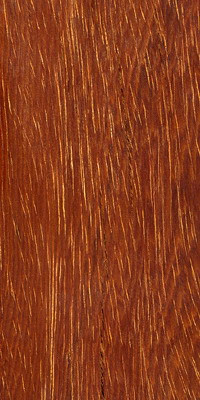

Dark red to purplish brown wood. Intermediate zone between sapwood and perfect wood (heartwood). White deposits in the pores.

Lophira alata, Lophira procera (synonymous)
Family:
OCHNACEAE (angiosperm)
Commercial restiction:
no commercial
News article:
Azobé chosen for Europe’s longest cycle bridge
Color: dark red
Sapwood: clearly demarcated
Texture: coarse
Grain: Interlocked
Interlocked grain: marked
Diameter: from 60 to 100 cm
Thickness of sapwood: from 2 to 4 cm
Floats: no
Log durability: good
Note: Dark red to purple brown wood. Intermediate zone between sapwood and heartwood. White deposits in the pores.
Note:1,060,0410,72,70,690,0110,30,97,31,028poorly stable96916221214203539
Physical and mechanical properties are based on mature heartwood specimens. These properties can vary greatly depending on origin and growth conditions.
Azobé MECHANICAL AND ACOUSTIC PROPERTIES
|
Mean |
Std dev. |
|
Mean |
Std dev. |
|
|
Specific gravity *: |
1,06 |
0,04 |
Crushing strength *: |
96 MPa |
9 MPa |
|
Monnin hardness *: |
10,7 |
2,7 |
Static bending strength *: |
162 MPa |
21 MPa |
|
Coeff. of volumetric shrinkage: |
0,69 % |
0,01 % |
Modulus of elasticity *: |
21420 MPa |
3539 MPa |
|
Total tangential shrinkage (TS): |
10,3 % |
0,9 % |
|
|
|
Total radial shrinkage (RS):
TS/RS ratio: Fiber saturation point:
7,3 %
1,4
28 %
1,0 %
(*: at 12% moisture content, with 1 MPa = 1 N/mm²)
Musical quality factor: 111,2 measured at 2569 Hz
Stability: poorly stable
Fungi and termite resistance refers to end-uses under temperate climate. Except for special comments on sapwood, natural durability is based on mature heartwood. Sapwood must always be considered as non-durable against wood degrading agents.
E.N. = Euro Norm
Funghi (according to E.N. standards): class 2 - durable
Dry wood borers: durable - sapwood demarcated (risk limited to sapwood)
Termites (according to E.N. standards): class D - durable
Treatability (according to E.N. standards): class 4 - not permeable
Use class ensured by natural durability: class 4 - in ground or fresh water contact Species covering the use class 5: Yes
Note: This species is listed in the European standard NF EN 350-2.
Transitional wood has a variable durability. Good resistance to marine borers in temperate water but moderate resistance in tropical water. This species is thus considerated as "moderately durable" towards marine borers and covers the use class 5 only when used in temperate or cold marine environment.
According to the European standard NF EN 335, performance length might be modified by the intensity of end-use exposition.
Against dry wood borer attacks: does not require any preservative treatment
In case of risk of temporary humidification: does not require any preservative treatment
In case of risk of permanent humidification: does not require any preservative treatment
Drying rate: slow Risk of distortion: high risk
Possible drying schedule: 1
Temperature (°C)
|
Risk of casehardening: no |
M.C. (%) |
dry-bulb |
wet-bulb |
Air humidity (%) |
|
Risk of checking: high risk |
Green |
40 |
37 |
82 |
|
Risk of collapse: no |
40 |
44 |
38 |
68 |
|
Note: Surface drying period recommended (3 to 4 months) |
30 |
44 |
36 |
59 |
|
(under shelter) prior to kiln drying. Drying very difficult |
20 |
46 |
36 |
52 |
|
for thickness > 38 mm. |
15 |
49 |
37 |
46 |
This schedule is given for information only and is applicable to thickness lower or equal to 38 mm. It must be used in compliance with the code of practice.
For thickness from 38 to 75 mm, the air relative humidity should be increased by 5 % at each step. For thickness over 75 mm, a 10 % increase should be considered.
Blunting effect: fairly high
Sawteeth recommended: stellite-tipped
Cutting tools: tungsten carbide
Peeling: not recommended or without interest
Slicing: not recommended or without interest
Note: Requires power. Log turning sawing recommended (internal stresses). Some difficulties in planing due to interlocked grain.
Nailing / screwing: good but pre-boring necessary
Gluing: correct (for interior only)
Note: Variable gluing properties. Gluing must be done carefully (dry wood and smooth surface) as the wood is very dense.
Appearance grading for sawn timbers:
According to SATA grading rules (1996)
For the "General Purpose Market":
- Possible grading for square edged timbers: choix I, choix II, choix III, choix IV
- Possible grading for short length lumbers: choix I, choix II
- Possible grading for short length rafters: choix I, choix II, choix III
For the "Special Market":
- Possible grading for strips and small boards (ou battens): choix I, choix II, choix III
- Possible grading for rafters: choix I, choix II, choix III
Conventional French grading:
- Thickness > 14 mm : M.3 (moderately inflammable)
- Thickness < 14 mm : M.4 (easily inflammable)
Euroclasses grading: D s2 d0
Default grading for solid wood, according to requirements of European standard EN 14081-1 annex C (April 2009). It concerns structural graded timber in vertical uses with mean density upper 0.35 and thickness upper 22 mm.
Hydraulic works (fresh water) Sleepers
Bridges (parts in contact with water or ground) Industrial or heavy flooring
Vehicle or container flooring Stairs (inside)
Heavy carpentry Bridges (parts not in contact with water or ground)
Wood frame house Cooperage
Poles Stakes
Resistant to one or several acids Hydraulic works (seawater) Note: For end-uses under permanent humidification, transition wood must be eliminated.
| Country Benin Cameroon Ivory Coast Ghana Nigeria Central African Republic Germany United Kingdom |
Local name EKI OKOKA AZOBE KAKU EBA KOFYO BONGOSSI EKKI |
Country Cameroon Congo Gabon Equatorial Guinea Nigeria Sierra Leone Germany |
Country BONGOSSI BONKOLE AKOGA AKOGA EKKI HENDUI BONKOLE |
use(s) for this species :